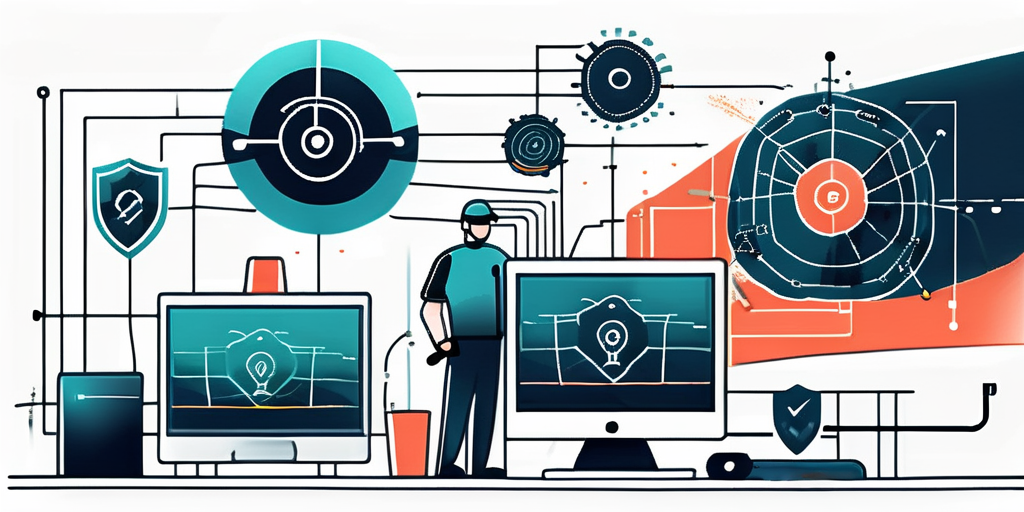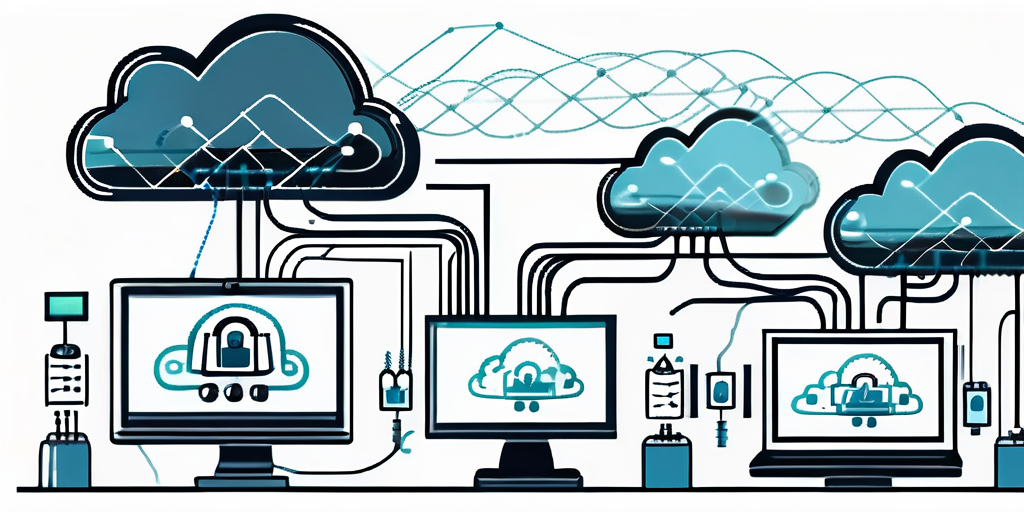Penetration testing is a critical component of cybersecurity, especially in cloud and hybrid environments. As the digital landscape continues to evolve, organizations must ensure that their systems are secure and protected against potential threats. In this article, we will explore the different strategies for conducting effective penetration testing in cloud and hybrid environments and the importance of this process in maintaining a robust cybersecurity posture.
Understanding Penetration Testing
Before diving into the strategies, it is crucial to have a clear understanding of what penetration testing entails and why it is essential. Penetration testing, also known as ethical hacking, is a systematic process of identifying vulnerabilities and weaknesses in a system or network infrastructure by simulating real-world attacks. Its main objective is to evaluate the security posture of an organization and provide recommendations for mitigating potential risks.
Penetration testing involves a series of carefully planned and executed steps. It starts with gathering information about the target system or network, including its architecture, operating systems, and applications. This information is crucial for identifying potential entry points and vulnerabilities.
Once the initial information gathering is complete, the penetration tester proceeds to the next phase, which is scanning and enumeration. This involves using various tools and techniques to identify open ports, services, and potential vulnerabilities. The goal is to gather as much information as possible to aid in the exploitation phase.
In the exploitation phase, the penetration tester attempts to exploit the identified vulnerabilities. This can involve using known exploits or developing custom exploits to gain unauthorized access to the target system or network. The objective is to demonstrate the impact of these vulnerabilities and the potential consequences if they were to be exploited by malicious actors.
After successfully exploiting the vulnerabilities, the penetration tester documents their findings and prepares a detailed report. This report includes a comprehensive analysis of the vulnerabilities discovered, their potential impact, and recommendations for remediation. The report serves as a roadmap for the organization to address the identified weaknesses and improve their overall security posture.
Definition and Importance of Penetration Testing
Penetration testing is a proactive approach to cybersecurity that helps organizations identify vulnerabilities before malicious actors can exploit them. By uncovering weaknesses in their systems, organizations can address and remediate these issues, reducing the risk of unauthorized access, data breaches, or other cyber threats. Regular penetration testing ensures that security measures are effective and helps organizations stay one step ahead of cybercriminals.
One of the key reasons why penetration testing is essential is that it provides organizations with a realistic assessment of their security posture. It goes beyond traditional vulnerability scanning by simulating real-world attacks and testing the effectiveness of existing security controls. This allows organizations to identify weaknesses that may not be apparent through other means and take proactive measures to strengthen their defenses.
Furthermore, penetration testing helps organizations meet regulatory and compliance requirements. Many industries, such as finance and healthcare, have specific regulations that mandate regular security assessments, including penetration testing. By conducting these tests, organizations can demonstrate their commitment to security and compliance.
The Role of Penetration Testing in Cybersecurity
Penetration testing plays a crucial role in an organization’s overall cybersecurity strategy. It helps identify security gaps and weaknesses that could be easily targeted by attackers. By conducting comprehensive penetration testing, organizations gain valuable insights into their security infrastructure, allowing them to implement measures to strengthen their defenses.
One of the key benefits of penetration testing is that it provides organizations with a proactive approach to security. Rather than waiting for an actual attack to occur, penetration testing allows organizations to identify vulnerabilities and address them before they can be exploited. This proactive approach helps organizations stay one step ahead of cybercriminals and minimize the potential impact of a successful attack.
Additionally, penetration testing helps organizations prioritize their security investments. By identifying the most critical vulnerabilities and weaknesses, organizations can allocate their resources effectively and focus on areas that require immediate attention. This ensures that limited resources are utilized efficiently and that security measures are aligned with the organization’s overall risk profile.
In conclusion, penetration testing is a critical component of a comprehensive cybersecurity strategy. It helps organizations identify vulnerabilities, assess their security posture, and implement measures to strengthen their defenses. By conducting regular penetration testing, organizations can stay ahead of cyber threats and minimize the potential impact of successful attacks.
Key Strategies for Effective Penetration Testing
Planning and Preparation
The first step in any successful penetration testing initiative is thorough planning and preparation. This involves defining the scope of the test, identifying the target systems, and establishing clear goals and objectives. Thorough planning ensures that the testing process is focused and efficient, maximizing the chances of identifying vulnerabilities and weaknesses in the target systems.

During the planning phase, it is essential to involve all relevant stakeholders, including IT administrators, security personnel, and management. This ensures that everyone is aware of the testing process and its objectives, minimizing potential disruptions and misunderstandings. By involving stakeholders, the organization can also benefit from their expertise and insights, enhancing the effectiveness of the penetration testing process.
Furthermore, planning and preparation should include a thorough understanding of the organization’s infrastructure and architecture. This includes identifying critical assets, such as servers, databases, and network devices, that need to be tested. By having a clear understanding of the organization’s infrastructure, the penetration testing team can focus their efforts on areas that are most likely to be targeted by potential attackers.
Conducting the Test
Once the planning phase is complete, the next step is to conduct the actual penetration test. This involves deploying a range of techniques and methodologies to identify vulnerabilities in the target systems or networks. The testing team may use both automated tools and manual techniques to simulate real-world attacks and test various attack vectors.
One of the key aspects of conducting an effective penetration test is to ensure comprehensive coverage. This means testing all possible attack vectors and scenarios that an attacker may exploit. This may include exploiting known vulnerabilities, password cracking, social engineering techniques, and even physical security assessments.
During the testing phase, it is important to maintain clear communication channels with the organization’s IT team. This allows for real-time collaboration and information sharing, enabling the testing team to address any unexpected issues or findings promptly. By working closely with the IT team, the penetration testers can also gain a deeper understanding of the organization’s security posture and provide tailored recommendations for improvement.
Analysis and Reporting
After the penetration test is completed, the next crucial step is to analyze the results and generate a detailed report. This report should provide a comprehensive assessment of the vulnerabilities identified during the testing process. It should include detailed descriptions of each vulnerability, including its impact and potential risks to the organization.
In addition to identifying vulnerabilities, the report should also provide recommended mitigation measures. These measures should be practical and actionable, allowing the organization to address the identified vulnerabilities effectively. The report should prioritize the vulnerabilities based on their severity and potential impact, helping the organization allocate resources and prioritize remediation efforts.
Furthermore, the report should be clear, concise, and easily understandable. It should be tailored to the organization’s technical and management teams, ensuring that they can comprehend the findings and recommendations without requiring extensive technical knowledge. This enables the organization to make informed decisions and take appropriate actions to improve their security posture.
It is also important to note that the penetration testing process is not a one-time event. Organizations should consider conducting regular penetration tests to ensure that their systems and networks remain secure against evolving threats. By regularly assessing their security measures, organizations can proactively identify and address vulnerabilities, reducing the risk of successful attacks.
Penetration Testing in Cloud Environments
Penetration testing in cloud environments presents a unique set of challenges. The distributed nature of cloud infrastructure, the shared responsibility model, and the dynamic nature of cloud services require a tailored approach to testing. Organizations must consider the specific cloud service models they are using, such as Infrastructure-as-a-Service (IaaS), Platform-as-a-Service (PaaS), or Software-as-a-Service (SaaS), and understand the associated risks and vulnerabilities.

Cloud environments offer numerous benefits, such as scalability, flexibility, and cost-efficiency. However, these advantages also introduce new risks and vulnerabilities that must be addressed through effective penetration testing. One of the key challenges in cloud environments is the distributed nature of the infrastructure. Unlike traditional on-premises environments, cloud infrastructure is spread across multiple data centers and regions, making it more challenging to identify and assess potential security weaknesses.
Another challenge is the shared responsibility model, where the cloud service provider is responsible for securing the underlying infrastructure, while the organization is responsible for securing their applications and data. This shared responsibility requires organizations to have a clear understanding of their security responsibilities and ensure that they are effectively testing their own applications and configurations.
The dynamic nature of cloud services also poses challenges for penetration testing. Cloud environments are highly scalable and can rapidly provision and deprovision resources based on demand. This dynamic nature introduces additional complexities in maintaining an up-to-date inventory of assets and conducting regular testing to ensure that new resources are properly secured.
Best Practices for Cloud Penetration Testing
Organizations should follow best practices to ensure effective penetration testing in cloud environments. These include understanding the cloud service provider’s security controls and limitations, ensuring proper access controls and segregation of duties, and conducting regular vulnerability assessments and patch management.
When conducting penetration testing in the cloud, it is crucial to understand the security controls provided by the cloud service provider. This includes understanding the physical security measures in place at the data centers, as well as the network security controls, such as firewalls and intrusion detection systems. By understanding these controls, organizations can identify any gaps or limitations and tailor their testing approach accordingly.
Access controls and segregation of duties are also critical in cloud environments. Organizations should ensure that only authorized individuals have access to the cloud resources and that there is proper segregation of duties to prevent any single individual from having excessive privileges. This can be achieved through the use of strong authentication mechanisms, such as multi-factor authentication, and implementing role-based access controls.
Regular vulnerability assessments and patch management are essential for maintaining the security of cloud environments. Organizations should conduct regular scans to identify any vulnerabilities in their cloud infrastructure and applications, and promptly apply patches and updates to mitigate these risks. This includes not only the operating systems and software running in the cloud, but also any third-party libraries or frameworks used in the development of applications.
It is essential to align the cloud penetration testing strategy with the organization’s overall risk management framework. This includes considering the specific risks and threats that are relevant to the organization’s industry and regulatory requirements. By aligning the penetration testing activities with the overall risk management framework, organizations can ensure that their testing efforts are focused on the most critical areas and provide the greatest value in terms of risk reduction.
Penetration Testing in Hybrid Environments
Navigating the Complexity of Hybrid Environments
Hybrid environments, which combine on-premises infrastructure with cloud services, pose unique challenges for penetration testing. Organizations must take into account the different security models, integration points, and potential vulnerabilities associated with hybrid systems. Understanding the flow of data and ensuring secure communications between on-premises and cloud components are key considerations.
Tailoring Strategies for Hybrid Systems
When designing penetration testing strategies for hybrid environments, organizations should focus on ensuring comprehensive coverage across both on-premises and cloud components. This may involve conducting separate penetration tests for each environment and considering the integration points for a complete security assessment. It is essential to have a clear understanding of the roles and responsibilities of all involved parties.
Tools and Technologies for Penetration Testing
Selecting the Right Tools
Choosing the appropriate tools and technologies for penetration testing is crucial to the success of the testing process. There are numerous tools available in the market, each with its own strengths and weaknesses. Organizations should consider factors such as the complexity of their systems, the skillset of their testing team, and the specific objectives they aim to achieve when selecting the right tools.

Leveraging Advanced Technologies
As technology advances, so do the techniques used by cybercriminals. To stay ahead of potential threats, organizations should leverage advanced technologies in their penetration testing efforts. This may include the use of machine learning algorithms for anomaly detection, artificial intelligence for intelligent attack simulations, or automated vulnerability scanners for efficient testing. However, it is important to note that these advanced technologies should complement human expertise rather than replace it.
In conclusion, effective penetration testing in cloud and hybrid environments requires careful planning, execution, and analysis. By understanding the unique challenges of these environments and adopting best practices, organizations can ensure that their systems are resilient to potential threats. With the right tools and technologies, organizations can enhance their penetration testing capabilities and stay one step ahead of cybercriminals. Regular and comprehensive penetration testing is essential to maintaining a strong cybersecurity posture in today’s ever-evolving digital landscape.
As you navigate the complexities of cloud and hybrid environments, the need for robust penetration testing becomes increasingly critical. Blue Goat Cyber, a Veteran-Owned business, is dedicated to securing your operations with specialized B2B cybersecurity services. Our expertise in medical device cybersecurity, HIPAA and FDA compliance, SOC 2, and PCI penetration testing ensures your infrastructure is resilient against threats. Contact us today for cybersecurity help and partner with a team that’s passionate about protecting businesses and products from attackers.


